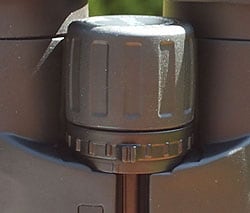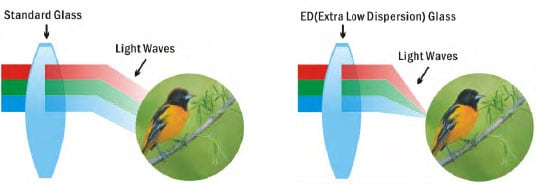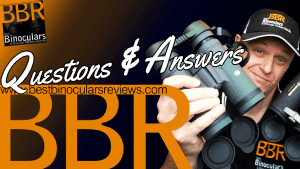

 |
||||||||||||||||
|
||||||||||||||||
The Helios Nirvana-ED binoculars are some of the companies highest spec models and come with a host of quality features that includes the use of extra-low dispersion glass (ED) glass in the lenses and Phase Correction Coatings on the roof prisms. I recently got the opportunity to try out the 8x42 version and below is my full review:
Main Highlights
The body of the 8x42 Helios Nirvana-ED is made from Magnesium, which helps to keep their weight down without having to compromise on strength or durability. This is then covered in a very hard rubber armoring, which has to be said is not as "grippy" as some that you get, but should provide the optics with plenty of protection. For some added grip they do have a texture moulded into the armor where your hands go when you are holding them.
This armour also protects the optics from small bumps and knocks and is less reflective than bare metal - bright sunlight shining off a metal object could frighten away wildlife. It also helps reduce the sound made from objects, especially metal ones striking against them that once again could frighten away timid birds or other wildlife. An example of this would be something like your watch or a wedding ring striking them as you grab hold of the binoculars.
Weight
Their weight of 24.0oz (680g) makes them fairly light for a full sized 8x42 binocular. You can find some lighter pairs of optics out there, but be careful as some also come with poor quality components made from sub-standard (but light) materials.
Dimensions
Length: 5.5in (14cm) - with the eyecups retracted and 5.9in (15cm) with the eyecups fully extended
Width:
4.3in (11cm) - with the inter-pupillary adjustment set to it's minimum and 5.1in (13cm) with the binoculars fully opened
Height: 2.2in (5.5cm)
These dimensions are fairly standard for a full sized 42mm binocular.
In my hands the 8x42 DCF roof prism Helios Nirvana-ED binoculars felt well balanced, were comfortable to hold and the focussing wheel was easy to adjust as well as being within easy reach without having to adjust your grip with the binoculars held up to your eyes.
Best Binoculars Rating for Body Stats: 8/10
The Eye Cups
The eye-cups look to be made from a hard plastic and are covered with a very thin rubber coating and I thought that they felt pretty comfortable even when pushed firmly against your face. The ocular lens has a diameter of 22mm, whilst the eyecup has an external diameter of 42mm.
The twist-up mechanism on the eyecups works well and they have one fixed intermediate stop about half way in-between fully extended and fully retracted. This combined with the very good 17.2 mm of eye relief should enable most eye-glass wearers to use these optics without having to remove their glasses. Non-eyeglass wearers will just use the eyecups in the fully extended position.
The 17.2mm of eye-relief also means that these optics easily make it onto my list of long eye relief binoculars where anything over 16mm is considered as long.
 Focusing
Focusing
The focussing wheel on the 8x42 Nirvana-ED has a hard rubber coating and a number of indentations in it to help with grip. It turns very smoothly, is easy to reach without changing your grip and takes about 1 and a quarter turns to go from infinity to it's closest focusing distance of 6.6 feet (2m).
This means that focusing from near to far (or vise versa) is reasonably quick, but can make fine tuning your focus a little trickier than binoculars that have a less aggressive mechanism as a small movement of the wheel moves the focusing plane a further distance.
Diopter Adjustment
Unlike the majority of binoculars where the diopter adjustment ring is on the right barrel near the eyepiece, these Nirvana-ED's have it located just behind the focusing wheel. It allows you to adjust the lenses separately to allow for differences in each of your eyes and plays an important part in correctly setting up & focusing your binoculars. Where it is located does make adjusting it simpler than if it were located on the barrel, but it does also mean that there is a greater chance of accidentally moving it when you are using the focusing ring.
The ring is notched which makes it easier to keep at the desired location, but there are no markings on it apart from the central (neutral) point, so if the setting for your eyesight is not neutral, I would suggest making your own mark incase it accidentally moves or you could remember the number of clicks left or right.
Waterproof & Fogproof
These 8x42 Helios binoculars are fully waterproof which not only protects them from moisture, but also prevents any dust and other small debris from entering them that could result in spoiling your view.
The air inside of the binocular has also been replaced with argon gas during the manufacturing process which makes it possible to use the binoculars in places where there are very low temperatures, high humidity levels or rapid temperature changes without the risk of any condensation forming on the inside the binocular. A side benefit of this is that it will protect their inner workings from corrosion.
Best Binoculars Rating for Body Construction Quality: 7/10
These binoculars come with quite a few high quality optical elements that are often only found on far more expensive optics, with the highlight being that they use extra-low dispersion glass (ED) in the lenses. By giving the designers of the multi-element objective lens a wider range of options to better direct and concentrate the wavelength of light, ED glass improves the quality of the image by helping to minimise chromatic aberration (color fringing). Generally speaking, the better the aberrations are controlled the cleaner and brighter the image will appear. Because of the costs involved and precision needed to make them, they are only found on high end cameras, telescopes, microscopes and binoculars.

Lens & Prism Coatings
As you would expect to find on any good quality roof prism binocular, Helios have used higher spec BaK-4 prisms as opposed to the cheaper and inferior BK-7 prisms in these Nirvana-ED binoculars. On these prisms they have also used a number of coatings to improve the image and reduce unwanted reflection of light.
They have Phase Correction Coatings on the prisms that help to keep the light in correct color phases and produces images that have better contrast, a higher resolution and have a better color reproduction.
Silver Coatings are also used on the roof prisms. Roof prism's have the advantage being aligned (as opposed to the off-set in Porro prisms) this enables manufacturers to make thinner more compact binoculars. But the problem with this design is that the prisms have one surface that does not have total internal reflection. It is therefore very important for the binoculars optical performance to raise the reflectivity of this surface. To do this many lower quality binoculars will use an aluminum mirror coating that has a reflectivity of between 87% to 93% . A silver mirror coating on the other hand has a reflectivity of between 95% to 98%, which is much better. I think it is important to point tout that whilst a silver coating is good, there is a better coating that that some higher end (an much more expensive) optics sometimes use called dielectric coatings that can provide a reflectivity of more than 99%.
The lenses on the Helios 8x42 Nirvana-ED binoculars are also fully multi-coated with anti-reflection coatings which increases light transmission to produce a brighter image and therefore better low light performance.
Best Binoculars Rating for Optical Components Quality: 8/10
The 8x42 Configuration
Binoculars with an 8x magnification and 42mm objective lenses are a common choice for most types of bird watching, wildlife observation and make good general use binoculars. This is because they strike a good balance between magnification and field of view, light gathering potential and size.
Good light gathering ability is important because quite often you will find yourself in situations where the lighting is sub-optimal, especially when birding or observing larger wildlife - like thickly wooded or forested areas, early in the morning just before or at sunrise or late afternoon when most birds and other animals are at their most active.
42mm objective lenses are big enough to let in plenty of light, but not so big that they make the binoculars difficult to easily carry about in the field. To explain how this configuration works, all 8x42 binoculars, these have an Exit Pupil of 5.25 and a Twilight Factor of 18.3, which if you compare them to an 8x32 setup, which has an exit pupil of 4 and a twilight factor of 16, it shows that the increased objective lens diameter will gather more light and make it possible for the binoculars to transmit more light.
For most uses, but especially birding, a wide field of view is also important, or at the very least is "desired". This is because it really helps you to quickly locate small, erratic and fast moving objects like birds and keep them within your "field of view".
If we compare them to a 10x42 binocular, that has a smaller exit pupil of 4.2mm, but do have a better twilight factor of 20.5 and therefore should show better detail in dim light. They will however most probably have a narrower field of view than an 8x42 and that is why, especially for birding an 8x magnification is often (not always) preferred to a 10x. There is also the point to remember that to make more powerful magnifications, thicker glass is needed and the thicker the glass, the less light that is transmitted through it.
It is also important to remember these figures do not take into account the transmittance or quality of the optical system, which is as important, if not even more so. The performance of a pair of optics in poor light also depends a lot on the quality of the glass and optical coatings and not just the exit pupil and twilight factor formula. Good coatings on the lenses and the prisms can double the amount of light that gets through the binocular, when compared to those that have none or poor quality coatings and as we have already discovered these Helios binoculars use some fairly good quality glass as well as coatings.
Field Of View
The field of view for these Helios 8x42 binoculars is 142m at 1000m / 426ft at 1000 yards (8.1°) - which is excellent, and it easily makes it onto my list of wide angle binoculars and is much wider than some of the very best binoculars out there, for example the Leica 8x42 Ultravid HD (389ft at 1,000 yards) and the Swarovski 8.5x42 EL Binoculars (399ft at 1,000 yards).
Close Focusing Distance
The minimum distance that you can focus on an object is 6.6 feet (2m) away, which is good. I consider anything under 6ft to be very good.
Best Binoculars Rating for Optical Stats: 8/10
So we have been over all the major optical components, their coatings and the 8x42 configuration but how does this all relate to the quality of the image that they produce? To be as objective and as constant as possible I compared the view through these with that of my control binoculars that I use for all of my reviews:
Brightness
Testing was conducted on a dull and overcast day: In terms of brightness, I could see slight improvement in terms of brightness of the image produced between these and that of my benchmark 8x42's. I therefore rate them fairly highly and classify the brightness of the image produced as very good.
Contrast
Image contrast was good and once correctly focussed on an objet the image is very sharp.
Colour Fringing
The amount of color fringing (chromatic aberration) around the edges of objects was very minimal and only really noticeable if you look at the edges of a light coloured object sitting in front of a dark background. Even then, you have to be really looking for it. I have seen better and I have also seen a lot worse and this is where the ED glass helps.
Softening
For binoculars that have such a wide field of view, it was impressive to see just how little the amount of softening of the image on the periphery of the view was.
So, to sum up, in regards to the overall quality of their image, I rate these Helios Nirvana-ED 8x42 binoculars highly and they as good as many binoculars that I have reviewed that are far more expensive than these.
Best Binoculars Rating for Image Quality: 8/10
Whilst it may not be completely fair to compare a mid-priced binocular like these Nirvana- ED's with the very top of the range, it can sometimes highlight their strengths and weaknesses. Below is a table comparing it with a range of other full size binoculars with magnifications of 8x. The very top of the range Leica 8x42 Ultravid HD, the Minox 8x43 HG Binoculars and the Kowa 8x42 BD
| Helios 8x42 ED | Leica 8x42 Ultravid HD | Minox 8x43 HG | Kowa 8x42 BD | |
| Price (approx): | �270 | $2100 (£1500) | $1100 (£640) | $550 (£590) |
| Weight: | 24.0ozs (680g) | 27.9ozs (791g) | 22.9ozs (649g) | 25.7ozs (729g) |
| Length: | 5.5in (14cm) | 5.63in (14.3cm) | 6.0in (15.2cm) | 5.7in (14.5cm) |
| Width: | 4.3in (10.9cm) | 4.72in (12cm) | 5.1in (13cm) | 5.0in (12.7cm) |
| Eye Relief: | 17.2mm | 15.5mm | 19.5mm | 18.3mm |
| Close Focusing Distance: | 6.6ft | 10.2ft | 8.2ft | 6.5ft |
| Field of View at 1000yds: | 426ft | 389ft | 379ft | 330ft |
| ED Glass | Yes | Yes | No | No |
| Phase Correction | Yes | Yes | Yes | Yes |
| Lens Coatings | Fully Multi-Coated | Fully Multi-Coated | Fully Multi-Coated | Fully Multi-Coated |
| Waterproof | Yes | Yes | Yes | Yes |
| Fogproof | Yes | Yes | Yes | Yes |
The black soft nylon carry case is very lightly padded comes with a short carry strap. I like the fact that it has an internal zipped mesh pocket, that always come in useful for storing thinks like lens cleaning cloths and sometimes even your car keys. It also has a loop on the back enabling you to attach it to a belt.
The black neck strap is very well padded and slightly curved which helps it to sit better on your neck and therefore is very comfortable. Many binoculars in this price range come with straight neck straps, so this is a nice touch and shows some good attention to detail.
The plastic objective lens caps click into the end of your binoculars. They fit very well, will protect your lenses and should not accidentally fall off. There is however no way of keeping them attached to your binocular once you remove them from your lens and so to prevent you from loosing them, you would probably have to put them into the carry case. This is fine, except it means that unless you keep taking them in and out your bag, you will leave your lenses exposed during the whole course of a walk for example and only cover them again once you put your optics away.
The soft rubber eye-piece covers fit very well and shouldn't accidentally fall off, but not so tight, that taking them off is a pain. They have loops on the ends of the cups that enable you to attach them to your neck strap. It has also been designed with a flexible bridge between the two cups that allow for the different distances between the two eyepieces depending on your inter-pupillary adjustment. This is something that is often overlooked by manufacturers meaning that the eyepiece covers wont fit, unless you store your binoculars fully open, which can be a real pain as you have to adjust them every time you use your optics and every time you put them away.
A lens cleaning cloth is also supplied as well as a basic user manual. It includes details on adjusting the eyecups, the inter-pupillary adjustment, dioptric correction, focusing and cleaning.
Tripod Adaptable
There is a small cover or cap on the front of the central pivoting point that screws off. This allows you to then screw on a binocular tripod adapter (not included) that uses the standard ¼-inch threading, which you can then attach to your tripod.
Best Binoculars Rating for Extras & Attention to Detail: 6/10
Strong Points: Two features really stand out with these Nirvana-ED binoculars: Their very wide field of view and they very good quality optical components that they use that produce a good quality image.
Weak points? Whilst the extras like the carry bag and the neck strap they are not bad, they fall a little short when you compare them to the very best (and far more expensive) binoculars.
Ideal Uses: Like most 8x42 binoculars, they are ideal birding binoculars, but when you take into account their excellent field of view and great optical performance, these do really make an excellent choice for bird watching. The same can be said for general wildlife observation, hunting and in my opinion would also make a good general use binocular.
For specialist uses like taking with you on a camping trip, on safari, or to an outdoor sporting event, they will also work very well when you are there, but some people may prefer a mid-sized or compact binocular that is just that much easier to carry.
So to sum up, if you are looking for a binocular with high quality optics that translates to a very good view, but don't fancy spending the mega sums of money that the "top end" brand names sell for, then you won't go too far wrong with these Helios Nirvana-ED 8x42 Binoculars.
I would like to thank Optical Vision Ltd. the UK distributor of Helios Binoculars for sending this one to me to review. I would also like to point out that this and all the other reviews on this site are my opinion and are not influenced in any way by manufacturers, distributors or suppliers.
Reviewed by Jason Whitehead for Best Binocular Reviews
|
Main Specifications & Features:

Below are similar pairs of Binoculars that you may also want to have a look at:
Affordable binoculars that feature a very wide field of view and high quality optics, including ED glass
General Price Range: (3/6) Mid Price Binoculars
Below is a link that will take you to a page with online retailers in both the US and UK that sell Helios 8x42 Nirvanna-ED Binoculars this page makes it easy to compare prices and then to buy from your preferred option:
|
Buy & Compare Prices for the Helios 8x42 Nirvanna-ED Binoculars |
||
US Shoppers |
Canadian Shoppers |
UK Shoppers |
Deutsch Shoppers |
Aussie Shoppers |
Indian Shoppers |

